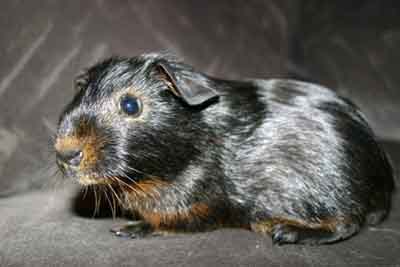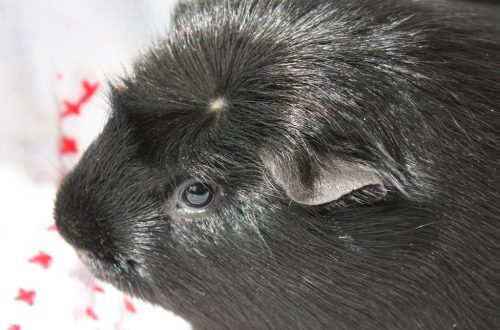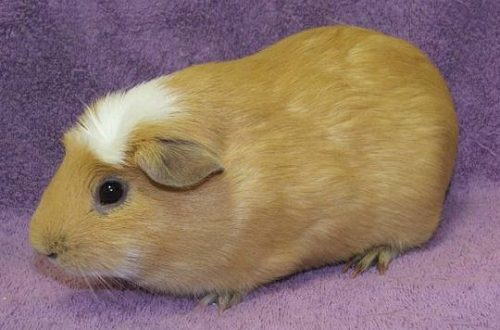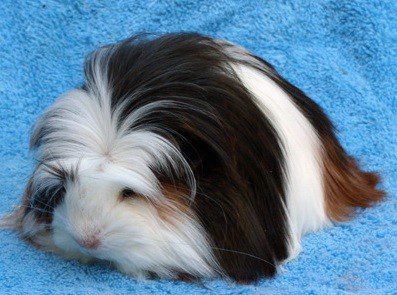
Guinea pig Coronet
We are confident that the coronet breed will take pride of place among guinea pig lovers, because it is impossible not to admire the sight of a pig of this breed.
The Coronet (Coronet Guinea Pig) is a long-haired breed of guinea pig, similar to the Sheltie breed, with a long, smooth coat growing from the head back all over the body. However, the main difference between Shelties and Coronets is that the latter have a crown-shaped rosette on top of their head, hence the name of the breed.
Coronet is one of the newest breeds of guinea pigs that has not yet become widespread, so now you can only buy a coronet pig from breeders who breed this breed.
We are confident that the coronet breed will take pride of place among guinea pig lovers, because it is impossible not to admire the sight of a pig of this breed.
The Coronet (Coronet Guinea Pig) is a long-haired breed of guinea pig, similar to the Sheltie breed, with a long, smooth coat growing from the head back all over the body. However, the main difference between Shelties and Coronets is that the latter have a crown-shaped rosette on top of their head, hence the name of the breed.
Coronet is one of the newest breeds of guinea pigs that has not yet become widespread, so now you can only buy a coronet pig from breeders who breed this breed.

Contents
From the history of coronet guinea pigs
As mentioned above, the breed is new, it appeared relatively recently, thanks to carefully thought-out selection. Breeder from England Claire White (Claire White) in the mid-70s of the last century crossed guinea pigs of two breeds – Sheltie and Crested. The result was a fusion of two genes, the same as in texels, only here the Coronets had the gene St (rosette on the head) and L, the gene responsible for long hair. The St gene is dominant while the L gene is recessive, and it took so many generations of pigs to finally get what we have at the moment. In any case, coronet guinea pigs are the product of hard work, not a happy accident. And the work on improving the breed that has been going on for many years has brought significant success.
The Coronet breed was officially recognized in the United States in 1998, when ARBA was included in the list of breeds recognized by the association.
As mentioned above, the breed is new, it appeared relatively recently, thanks to carefully thought-out selection. Breeder from England Claire White (Claire White) in the mid-70s of the last century crossed guinea pigs of two breeds – Sheltie and Crested. The result was a fusion of two genes, the same as in texels, only here the Coronets had the gene St (rosette on the head) and L, the gene responsible for long hair. The St gene is dominant while the L gene is recessive, and it took so many generations of pigs to finally get what we have at the moment. In any case, coronet guinea pigs are the product of hard work, not a happy accident. And the work on improving the breed that has been going on for many years has brought significant success.
The Coronet breed was officially recognized in the United States in 1998, when ARBA was included in the list of breeds recognized by the association.
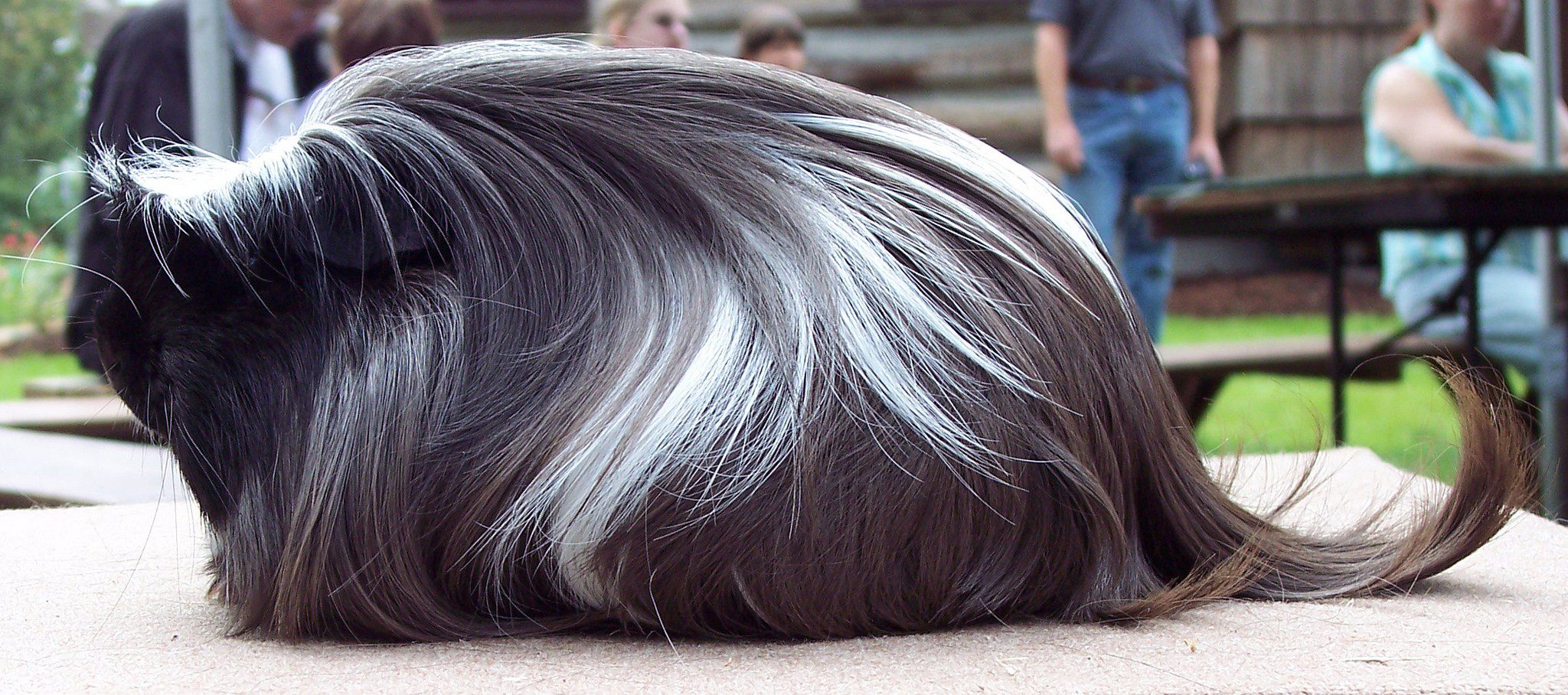
Features of coronet guinea pigs
So, the main distinguishing features of coronets are long, smooth hair, like a sheltie, and a crest, like a crested. The crests of coronets can be of any color. And the color of these pigs can also be of any shade and color: the standards allow any variations, both single-color and with a combination of several colors.
In addition, there may be satin coronets, with a more shiny, smooth and dense fur coat that shimmers in the light and looks like satin. The average lifespan of coronets ranges from 6 to 8 years.
The Coronet breed, due to its long hair, is not ideal for beginner pig breeders or for children. The main advantage of the coronet – its coat – will require additional daily care.
So, the main distinguishing features of coronets are long, smooth hair, like a sheltie, and a crest, like a crested. The crests of coronets can be of any color. And the color of these pigs can also be of any shade and color: the standards allow any variations, both single-color and with a combination of several colors.
In addition, there may be satin coronets, with a more shiny, smooth and dense fur coat that shimmers in the light and looks like satin. The average lifespan of coronets ranges from 6 to 8 years.
The Coronet breed, due to its long hair, is not ideal for beginner pig breeders or for children. The main advantage of the coronet – its coat – will require additional daily care.
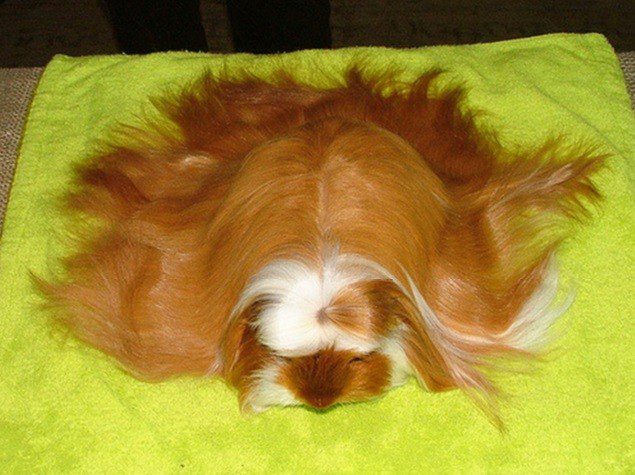
Care and maintenance of coronets
Caring for coronets is not much different from caring for other breeds of pigs. Only because of the long coat they require daily inspection. This fact must be taken into account before you decide to have such a pig or want to start breeding. The most important requirement is more time. If not properly cared for, their hair will become tangled and unpleasant for both the pig and the owner.
To care for the hair of show-class pigs, papillots are most often used.
Caring for coronets is not much different from caring for other breeds of pigs. Only because of the long coat they require daily inspection. This fact must be taken into account before you decide to have such a pig or want to start breeding. The most important requirement is more time. If not properly cared for, their hair will become tangled and unpleasant for both the pig and the owner.
To care for the hair of show-class pigs, papillots are most often used.
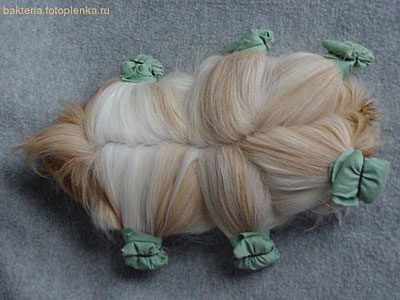
Here is what the well-known coronet breeder Dorothy Wilson, Cherished Cavies kennel, writes about leaving:
“I spend a lot of time looking after my gilts every day.
They live in small groups of two to four in very large cages that I keep in the basement. In each cage, the pigs have a lot of toys so that they do not get bored and a lot of houses – so that there is where to sleep. Every night I spend about an hour getting everyone water and fresh vegetables. When I’m downstairs (in the basement) I pick out a few pigs and take them to my bedroom to prepare them for shows. Cage cleaning takes 8 hours a week, after all the cages are cleaned, I begin to inspect each gilt. I cut my nails, sort out the tangles in the wool. Those pigs that are in the bedroom are very carefully examined once every two days, the hair is groomed and is in hairpins.
And when the pig’s show career ends, the train is trimmed for the pig’s comfort.
It takes a huge amount of time, but I enjoy the time I spend with the pigs.”
Here is what the well-known coronet breeder Dorothy Wilson, Cherished Cavies kennel, writes about leaving:
“I spend a lot of time looking after my gilts every day.
They live in small groups of two to four in very large cages that I keep in the basement. In each cage, the pigs have a lot of toys so that they do not get bored and a lot of houses – so that there is where to sleep. Every night I spend about an hour getting everyone water and fresh vegetables. When I’m downstairs (in the basement) I pick out a few pigs and take them to my bedroom to prepare them for shows. Cage cleaning takes 8 hours a week, after all the cages are cleaned, I begin to inspect each gilt. I cut my nails, sort out the tangles in the wool. Those pigs that are in the bedroom are very carefully examined once every two days, the hair is groomed and is in hairpins.
And when the pig’s show career ends, the train is trimmed for the pig’s comfort.
It takes a huge amount of time, but I enjoy the time I spend with the pigs.”
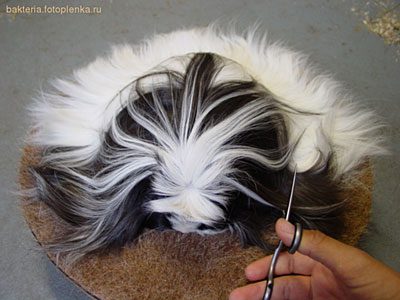
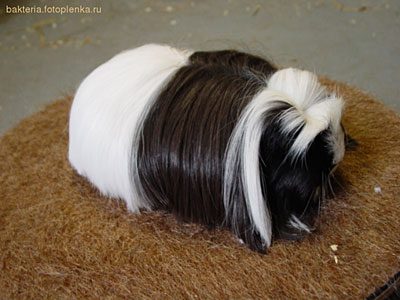
Coronet, like other guinea pigs, is only suitable for home keeping, such pets cannot live on the street. You can (and should!) let them go outside for a walk in the warm season. And in winter it will be enough to walk around the room. Guinea pigs need a lot of movement and love to play and explore the world around them.
The optimum temperature for keeping coronets is 17-25 degrees Celsius. Due to the presence of long hair at higher temperatures in summer, heat stroke can occur in a pig, so walking your pet outside, you should always make sure that the pig does not stay in the sun for a long time. Shade in the summer will be more preferable.
For a healthy and happy active life, a guinea pig needs a good home and a proper diet. Well, and your love and affection, of course. Compliance with these simple requirements will ensure your pet a long and healthy life.
Guinea pigs are very social creatures, loneliness is detrimental to them and can affect their health and character. The ideal option would be to keep these animals in same-sex couples.
Coronet, like other guinea pigs, is only suitable for home keeping, such pets cannot live on the street. You can (and should!) let them go outside for a walk in the warm season. And in winter it will be enough to walk around the room. Guinea pigs need a lot of movement and love to play and explore the world around them.
The optimum temperature for keeping coronets is 17-25 degrees Celsius. Due to the presence of long hair at higher temperatures in summer, heat stroke can occur in a pig, so walking your pet outside, you should always make sure that the pig does not stay in the sun for a long time. Shade in the summer will be more preferable.
For a healthy and happy active life, a guinea pig needs a good home and a proper diet. Well, and your love and affection, of course. Compliance with these simple requirements will ensure your pet a long and healthy life.
Guinea pigs are very social creatures, loneliness is detrimental to them and can affect their health and character. The ideal option would be to keep these animals in same-sex couples.
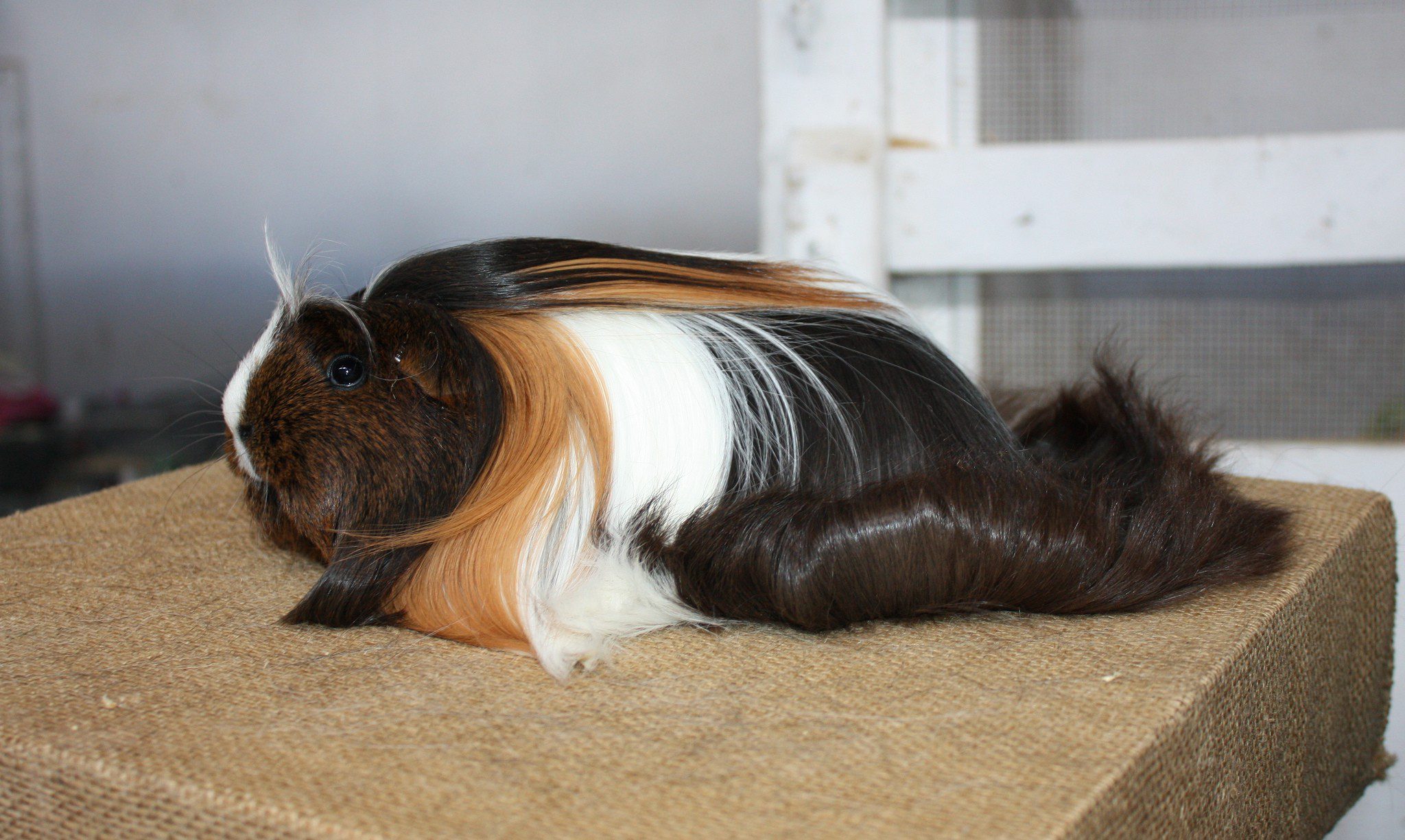
Cage for coronets
Every guinea pig needs a home. Most often it is a cell. The main requirement for a cage is space. Guinea pigs are quite active and mobile animals, it is vital for them to move a lot. The minimum allowable cage area for a guinea pig is 0,6 square meters, which corresponds to a size of 100×60 cm. All those cages that are smaller are not suitable for guinea pigs. Of course, you can put your pet in a smaller cage, but in this case, you need to be prepared for possible future health problems and the nature of the guinea pig.
Read about what a cage should be in the article “Cage for a guinea pig”
Every guinea pig needs a home. Most often it is a cell. The main requirement for a cage is space. Guinea pigs are quite active and mobile animals, it is vital for them to move a lot. The minimum allowable cage area for a guinea pig is 0,6 square meters, which corresponds to a size of 100×60 cm. All those cages that are smaller are not suitable for guinea pigs. Of course, you can put your pet in a smaller cage, but in this case, you need to be prepared for possible future health problems and the nature of the guinea pig.
Read about what a cage should be in the article “Cage for a guinea pig”
What to feed coronets?
Just like all guinea pigs, coronets are herbivores. Their main food is vegetables, fruits, fresh grass or hay, special pellets and clean drinking water. In addition, experts recommend adding vitamin C to food or water, since guinea pigs, along with humans, are a rare species of mammals in whose body vitamin C is not synthesized, but only comes from outside.
Read more about the intricacies of guinea pig nutrition in the “Nutrition” section of the same name.
Just like all guinea pigs, coronets are herbivores. Their main food is vegetables, fruits, fresh grass or hay, special pellets and clean drinking water. In addition, experts recommend adding vitamin C to food or water, since guinea pigs, along with humans, are a rare species of mammals in whose body vitamin C is not synthesized, but only comes from outside.
Read more about the intricacies of guinea pig nutrition in the “Nutrition” section of the same name.

Coronet hair care
The long coat of Coronets needs more care than the coat of short-haired guinea pig breeds. If you do not take care of the appearance of the coronet coat, it can become tangled or lose its luster.
In principle, there is nothing complicated and prohibitive in the care. It is enough to brush and trim it regularly. To do this, you will need a special comb-comb or brush and sharp scissors.
When caring for coronets, special attention should be paid to the hair near the anus. Here it needs to be cut as short as possible, as excrement can pollute it.
If your pet does not participate in exhibitions and shows, then the coat can be cut to a comfortable length. This will make life much easier for yourself and your guinea pig.
For show class animals, the best option would be a grooming procedure once or twice a month.
So regular brushing and combing is the key to keeping the Coronet looking great, and if you don’t have the time to do that, it might be worth choosing a less whimsical pet.
The long coat of Coronets needs more care than the coat of short-haired guinea pig breeds. If you do not take care of the appearance of the coronet coat, it can become tangled or lose its luster.
In principle, there is nothing complicated and prohibitive in the care. It is enough to brush and trim it regularly. To do this, you will need a special comb-comb or brush and sharp scissors.
When caring for coronets, special attention should be paid to the hair near the anus. Here it needs to be cut as short as possible, as excrement can pollute it.
If your pet does not participate in exhibitions and shows, then the coat can be cut to a comfortable length. This will make life much easier for yourself and your guinea pig.
For show class animals, the best option would be a grooming procedure once or twice a month.
So regular brushing and combing is the key to keeping the Coronet looking great, and if you don’t have the time to do that, it might be worth choosing a less whimsical pet.
Do coronets need to be bathed?
There is no consensus on this among breeders. Someone does not recommend bathing guinea pigs at all, someone believes that coronets should be bathed at least once a month. The decision, as always, is yours. Just please, never bathe a pig on a whim. Any contact with water is always stressful for these animals. A bath must be a necessity. Due to severe pollution, for example.
There is no consensus on this among breeders. Someone does not recommend bathing guinea pigs at all, someone believes that coronets should be bathed at least once a month. The decision, as always, is yours. Just please, never bathe a pig on a whim. Any contact with water is always stressful for these animals. A bath must be a necessity. Due to severe pollution, for example.
Nail clipping
Also, please remember to give your pet a manicure once a month. Too long claws can cause discomfort to the guinea pig.
Also, please remember to give your pet a manicure once a month. Too long claws can cause discomfort to the guinea pig.
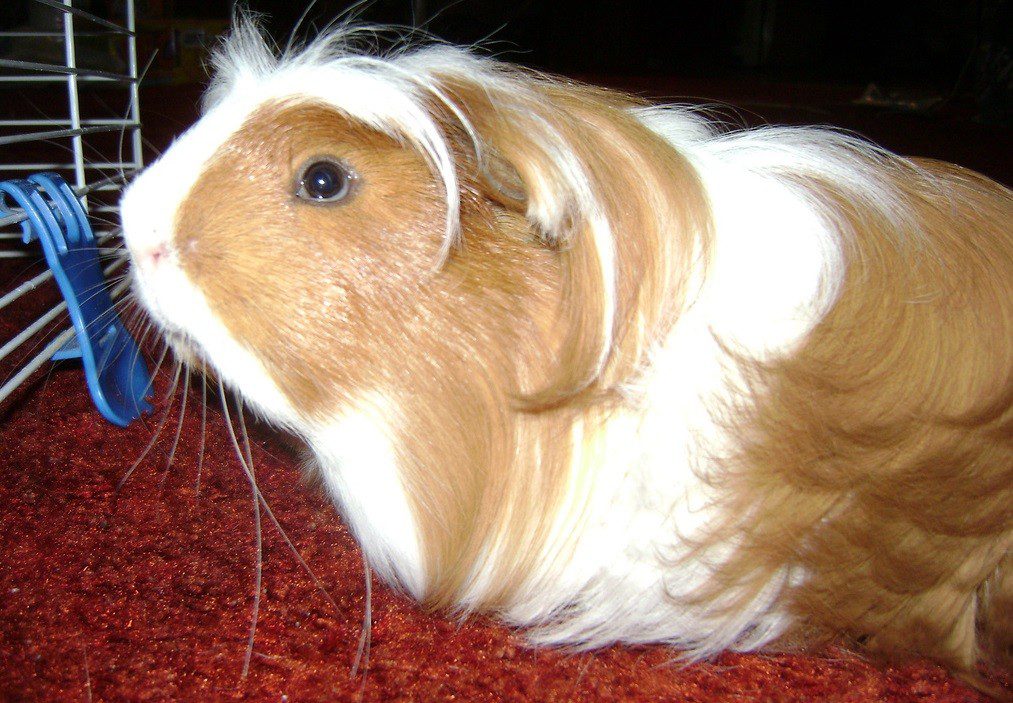
Character of coronets
Coronet pig lovers say that these pigs are curious, playful and affectionate. They love attention and seek out people, although they naturally attract it with their funny antics and unusual appearance. If you want a fun-loving pet or a show guinea pig, then a coronet is a great choice.
But at the same time, they are not recommended for those with little experience in caring for guinea pigs due to the amount of care required.
Coronet pig lovers say that these pigs are curious, playful and affectionate. They love attention and seek out people, although they naturally attract it with their funny antics and unusual appearance. If you want a fun-loving pet or a show guinea pig, then a coronet is a great choice.
But at the same time, they are not recommended for those with little experience in caring for guinea pigs due to the amount of care required.



